Bloodhound is one of the largest and oldest representatives of the group hound. This is a tracker dog with a phenomenal sense of smell, as well as an extraordinary image, including long, curled ears and a “flowing” profile of the muzzle.
Bloodhounds are imperturbable kind-hearted and first-class detectives who will get out of the ground any prey that has the slightest perceptible smell. At the same time, the breed is not tied to its historical craft (hunting) and, if necessary, can easily be converted into a service bloodhound or companion. But what a bloodhound will definitely not become is a sofa dog, so before taking a hound puppy, do jogging or race walking in advance – you will have to walk with your pet for a long time and intensively.
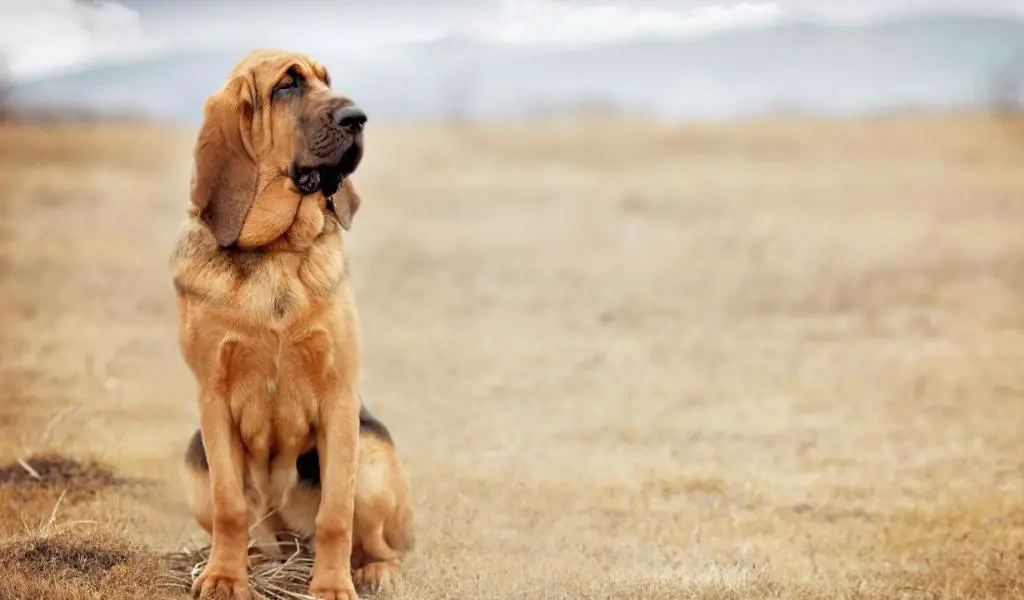
Bloodhounds are dogs so ancient that it is almost impossible to trace their origins and distant ancestors. For example, for a long time the hounds from the Ardennes Monastery (Belgium), later called the dogs of Saint Hubert, were considered the ancestors of the breed, according to the second name of the monastery. The monks of the abbey already in the 9th century discovered interbreeding for themselves and practiced it diligently, using Molossians, Belga bloodhounds, and North African hounds as breeding material.
Monastic dogs or Saint-Huers, as they were christened in Europe, had a textured appearance. Gigantic physique, with massive heads, weighed down with multiple wrinkles and giant flews, they perfectly chased the big game, for which they were loved by the Belgian nobility. Since the Ardennes carefully guarded the secret of the origin of their wards, hounds like them were not bred anywhere else. However, the forced isolation did not prevent the breed’s popularity and spread, since the Belgian clergy shared their pets with the French royal family, who used animals for hunting deer.
In the 19th century, the Russian zoologist L.P. Sabaneev proposed his own version of the origin of the Bloodhounds. In his opinion, the ancestors of the breed were not Ardennes dogs at all, but Norman hounds – a breed bred in the 11th century by crossing Saint-Huers with French hounds. This variety was especially cultivated by the Normans, who at that time overwhelmed the English territories and brought their four-legged favorites to them. Subsequently, the Norman hounds were crossed with English mastiff dogs, in particular, with mastiffs, which gave the world bloodhounds. This version is also supported by the fact that today’s representatives of the breed have a tubular “design” of ears, not typical for Saint-Huers, but typical for French (Norman) hounds.
By the beginning of the 17th century, bloodhounds had become super popular, and some individuals even managed to cross the Atlantic and consolidate their positions in the New World. True, unlike Europe, which was obsessed with hunting, a different mission awaited hounds in America. They began to be used to search for people, or rather, to catch slaves fleeing from fierce masters, and then to pursue fugitive convicts. It was thanks to this imposed specialization that the animals gained a reputation as ruthless detectives, due to which the breed was almost completely exterminated during the civil war. By the way, modern researchers believe that slaves in the USA were “hunted” not with purebred bloodhounds, but with their mestizos.
In Europe, hounds were also used as bloodhounds. For example, in 1616 in Great Britain there was a law that ordered to keep a Bloodhound on guard duty every sixth parish. Around this time, another decree dates back to which the bloodhound had the right to take a trace in the houses of residents, who were obliged to provide him with all possible assistance and open the doors of the dwelling in front of the animal’s nose. Particularly courageous, who refused to cooperate with the “brute investigator” and locked themselves in their homes, faced a sad outcome – the death penalty.
The breed was imported to Russia by Peter I. Several bloodhounds were purchased for a fabulous sum for those times to place them in the Izmailovsky menagerie. However, after the death of the autocrat-reformer, interest in animals was lost, so it was only in the 80s of the 20th century that Belgian hounds were really bred in domestic nurseries.
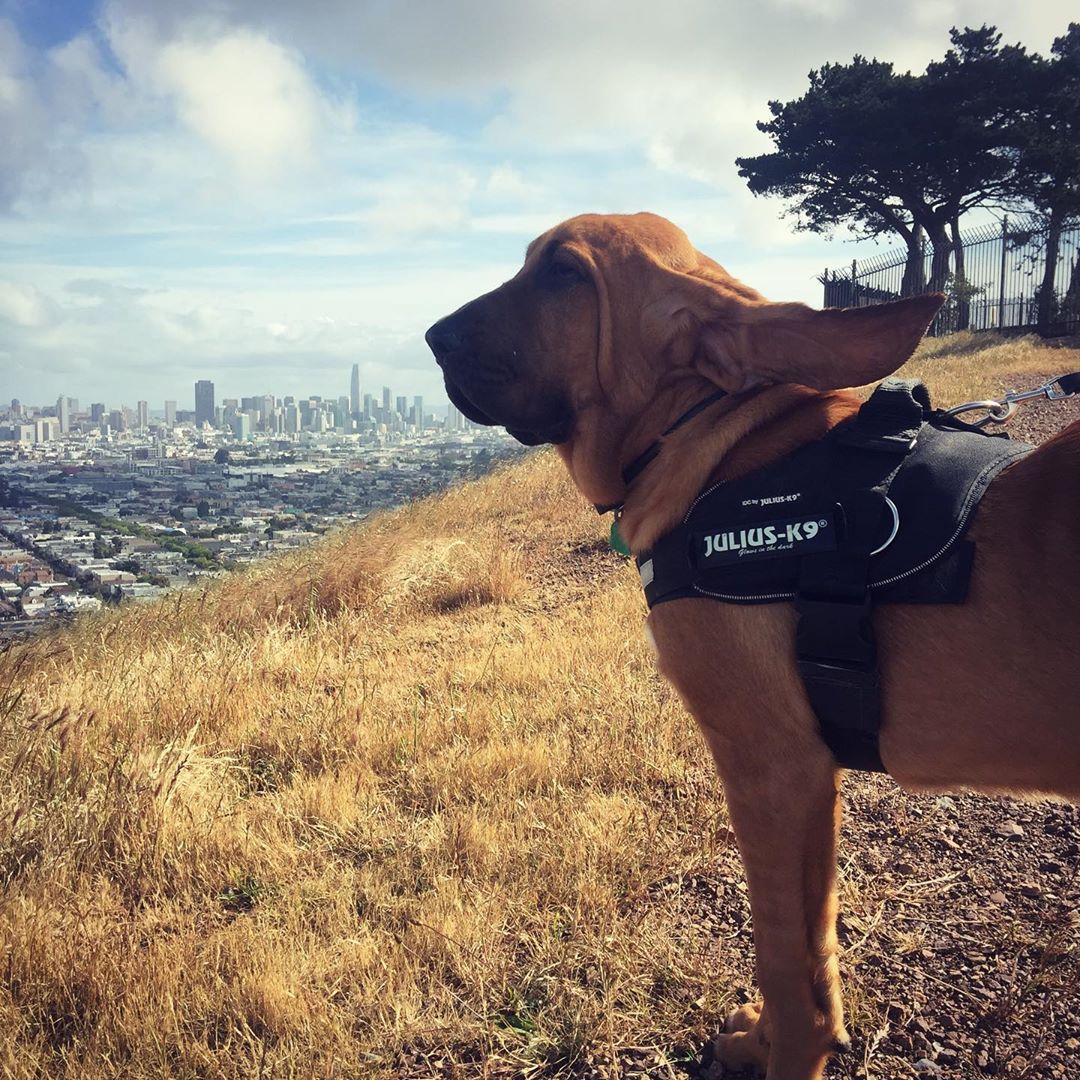
The descendants of the Saint-Hubert have a bright, memorable exterior and strong physique. Massive skeleton, voluminous, well-developed muscle mass, rectangular body format – all this gives the animal’s appearance brutal solidity and stylish imposingness. At the same time, excessively exaggerated (upward) dimensions are considered as a defect that can affect the dog’s show career.
The most expressive part of the Bloodhound’s body is, of course, the head: framed by soft long ears, reminiscent of an English lord’s wig, with spectacular flews and noble folds on the forehead. In addition, the breed has a very special expression of the muzzle: no matter what mood the dog is in, its appearance will amaze with its majesty and nobility. The smart, slightly detached look of the bloodhound, which creates the impression that the animal has comprehended all the secrets of the universe and now sees through every person, including the owner, cannot but sink into the soul.
The breed standard provides for a height at the withers of 64-72 cm for males and 58-66 cm for females Male Blankhounds should weigh between 46 and 54 kg, female Blankhounds 40-48 kg.
The head is massive, with a deep, laterally flattened skull and a relatively narrow profile. The superciliary arches are inexpressive, as are the feet, but the occipital protuberance is prominent, well-defined. The Bloodhound’s muzzle is thickened in the area of the nostrils, voluminous along the entire length, with a flat, slightly convex line.
The lips are soft, stretched, forming an almost square profile, while the upper lip covers the lower jaw, hanging 5 cm down. In the area of the corners, the lips are transformed into plump flews, and these, in turn, turn into a heavy dewlap (in “girls” the fleecy is less pronounced).
Bloodhounds have strong white teeth that meet in a classic scissor (preferred) or pincer bite.
The developed wide nose is black in black and tan bloodhounds and brown or black in other colors.
Bloodhound has medium-sized eyes with no tendency to bulge. The standard shades of the iris are dark and light brown, and for individuals that do not have a black cloak/saddle on the coat, lighter options, for example, amber, is acceptable. The look of the dog is smart, a little indifferent, very similar to the look of a basset hound.
The auricle is long, flexible, rolled inward or backward. In qualified individuals, the ears are set in line with the eyes or below and have a velvety short coat.
The neck is of normal length, allowing the dog attacking the trail to keep its nose close to the ground. The skin on the throat is loosely hanging, passing to the middle of the throat into a thick double dewlap (less noticeable in females .
The muscular, developed body of the Bloodhound is distinguished by a stretched rectangular format. The lines of the back and abdomen are straight, parallel to each other. The loin of the dog is massive, short. The croup is fleshy, without a pronounced bevel, almost horizontal. The rib cage is wide, long, strongly lowered from top to bottom, with a pronounced keel.
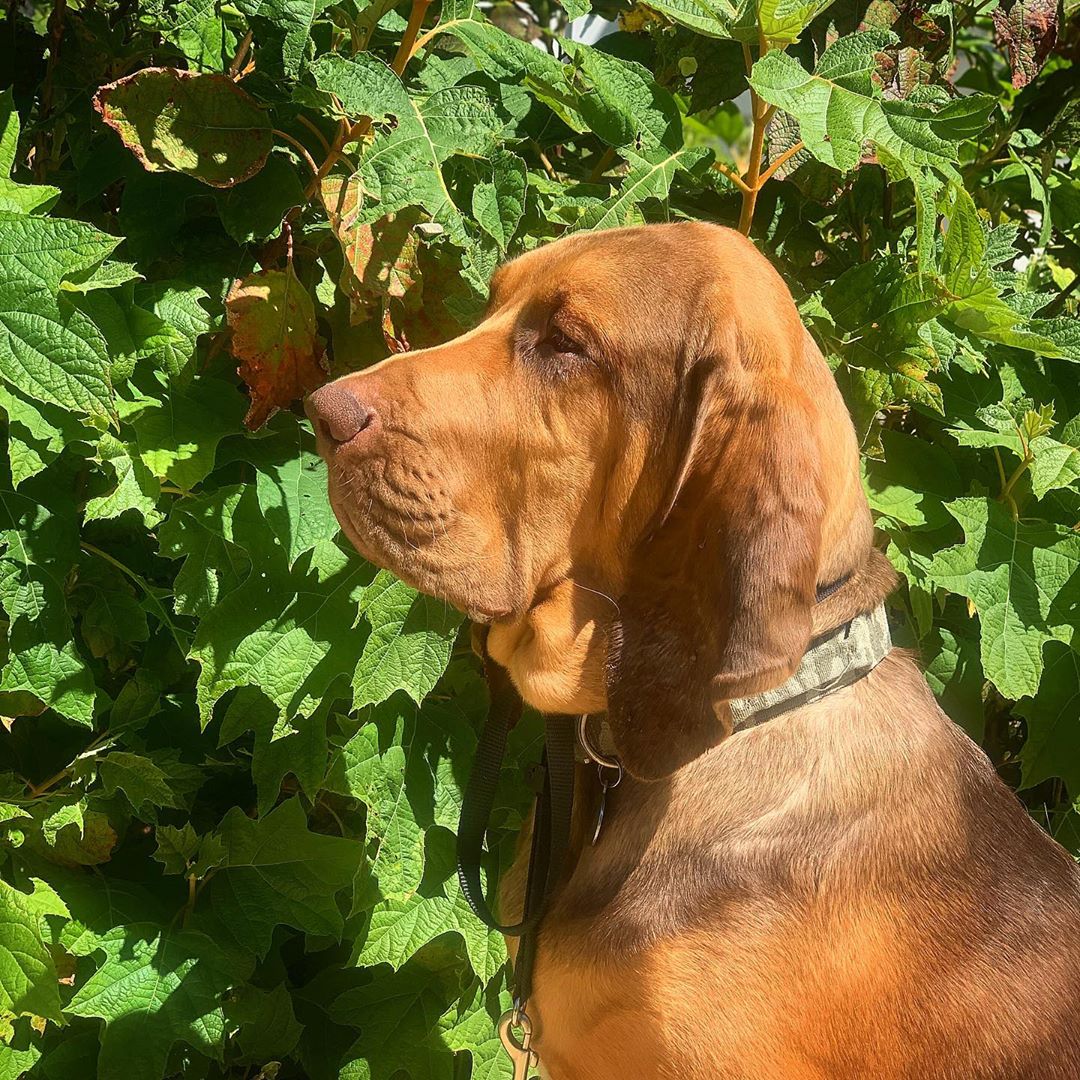
For instance, the Bloodhound’s strong, muscular legs appear straight and parallel to each other. Long, sloping shoulder blades in conjunction with the elongated shoulder form free angles. The elbows are set straight, without eversion, the pasterns give the impression of being strong, fixed at a slight slope.
The thighs and legs of the dog are voluminous, with clearly visible muscles. The hock joint is low, “flowing” into the strong short metatarsus. When hunting, the Bloodhound moves at a beautiful free trot without arching its back.
The skin is elastic, well stretched, forming large folds on the forehead and the sides of the muzzle. Wrinkles on the body and the rest of the body are discouraged.
The fat saber tail of the Bloodhound is a logical extension of its spine. The tail is set low and has a good length. In motion, it rises above the line of the spine, without twisting into a corkscrew and falling on its side.
The Bloodhound coat is not uniform. On the ears, the hair is soft, silky, but ultra-short. The rest of the body is covered with a longer, denser, and coarser dog, which protects the skin well from external influences.
A typical bloodhound comes in one or two colors. The coat of monochromatic individuals is all shades of red, ranging from light red to dark red suit. Bicolor dogs are either black or liver and tan.
The amount of black tone can be different, and therefore hounds are divided into animals with a saddle cloth and a cloak. In caped Bloodhounds, tan patches prevail over the black tone concentrated in the back. Dogs with a coat have tan markings on the limbs, cheekbones, brows, chest, muzzle, and under the tail, while the black color occupies most of the body.
Not considered a vice, but not welcome either: tiny white marks on the tip of the tail, fingers, sternum; faded tan and pale red color in monochromatic hounds.
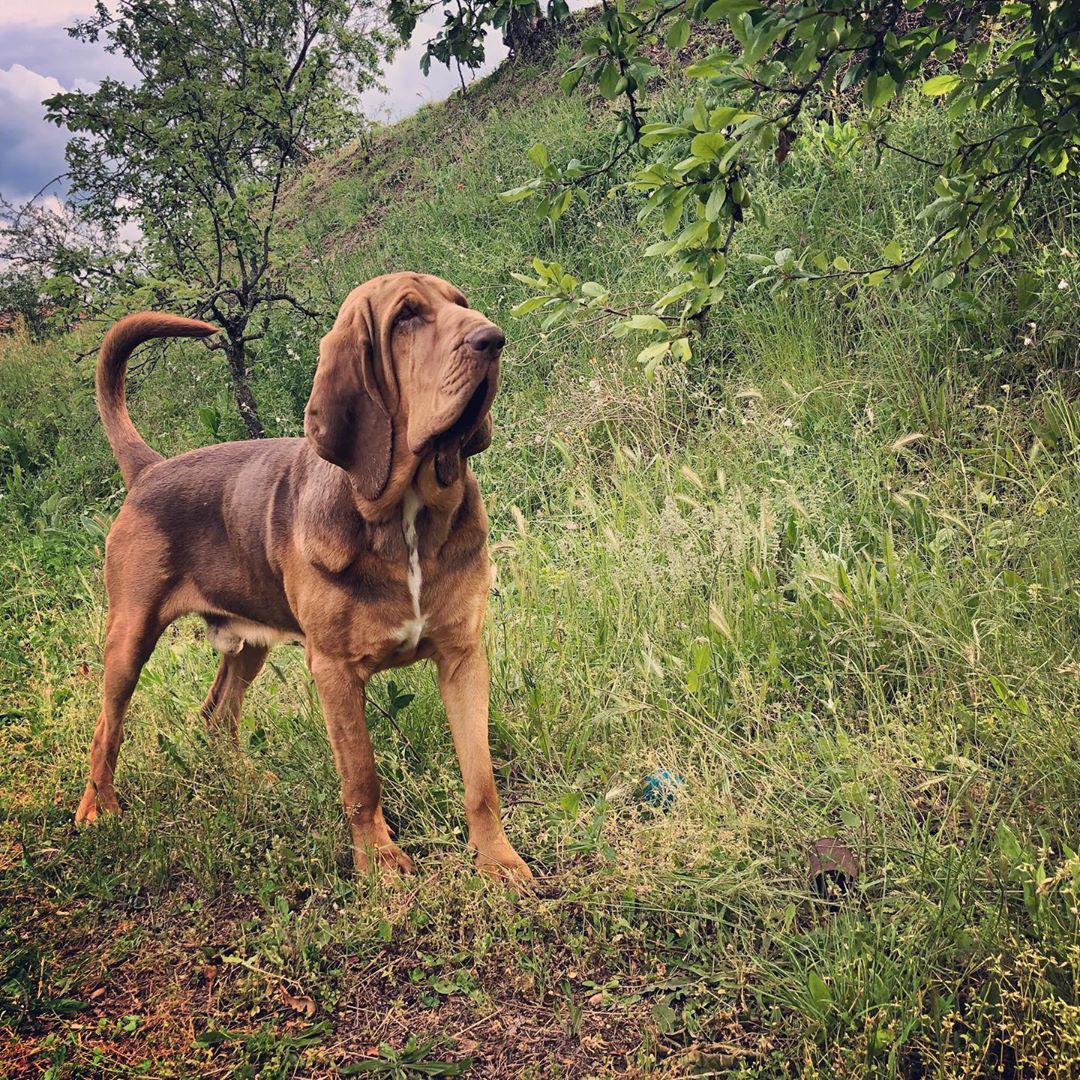
The same external defect, depending on the severity, can be regarded both as a slight defect and as a reason for disqualification at the show. In the case of bloodhounds, exclusion from the ring can be obtained due to the following developmental defects:
- fearfulness / excessive viciousness;
- non-compliance with the dimensions specified by the standard;
- the light shade of the iris of the eyes;
- bite defects, including crookedness and misalignment of the jaws;
- lack of pigmentation on the lips and nose;
- atypical nose colors: black and tan bloodhounds have any tone except black; in
- monochromatic individuals – all colors, except for liver and black;
- white spots in places not specified by the standard, as well as oversized white marks;
- poorly expressed breed features.
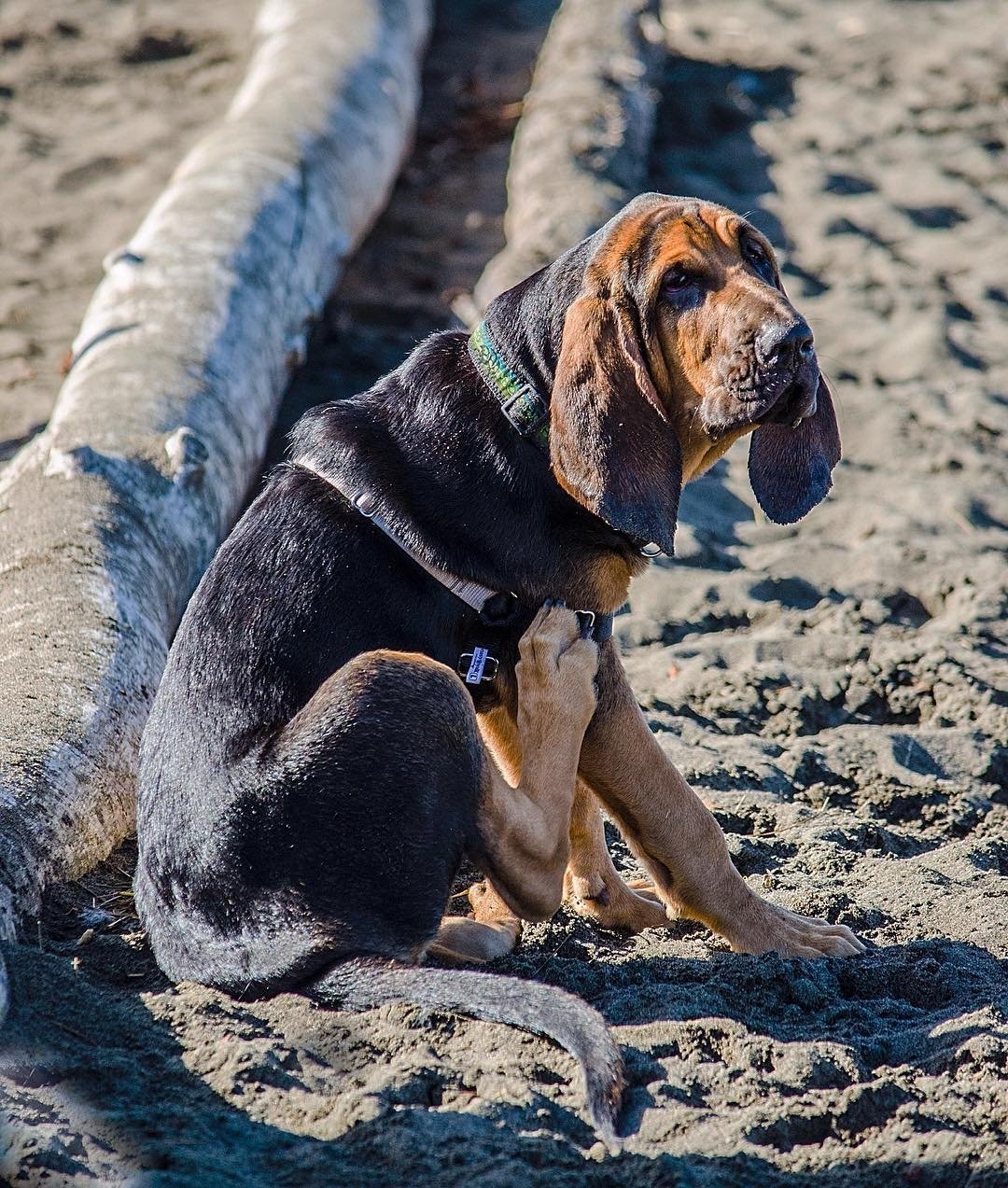
The descendants of the Norman hounds are balanced to the point of phlegmatic and rather good-natured dogs. True, one should not confuse the calm temperament of the breed with weakness. Bloodhounds are infinitely far from soft “felt boots”, and they will not allow anyone but children to twist ropes from themselves. Hounds, of course, are happy to be friends with a person, but as a comrade and certainly not as a disenfranchised pet, for which all decisions are made by the owner. By the way, to the question about children: Bloodhound really enjoys playing with babies and will never offend a child on purpose. And yet, it is better not to forget about the dimensions of an animal capable of knocking a one-year-old toddler off his feet with one wave of its tail.
Fans of the breed assure that the Bloodhound can safely lead the top of the most family and human-oriented pets. He is smart, has a conflict-free, easygoing character, and is utterly devoted to the person who took him into his upbringing. The Bloodhound is also quite loyal to people who are not part of his circle of acquaintances, so feel free to invite noisy companies into the house – the Belgian hounds are glad to see guests completely sincerely and they certainly will not be spying on them. Bloodhounds are especially fond of traditional celebrations that are repeated from year to year. In their personal calendar, dogs put a mental note in front of each such event and willingly take part in the reception and entertainment of guests.
Sometimes among the “Belgians”, there are overly timid and shy natures who prefer silence and solitude to collective entertainment. But in general, the Bloodhound is a sociable and sociable breed. For example, its representatives easily join the crowd of other four-legged pets, do not scoff at cats, and rarely sort things out with each other (no one canceled the skirmishes between two males or females .
Bloodhound barks rarely, but accurately: a low “trumpet voice” emanating from the dog is clearly audible at a distance of several kilometers. On the hunt, this quality, of course, does not hurt, but at home … However, no panic. The animal will arrange vocal exercises only in exceptional cases so that such concerts are experienced easily and painlessly.
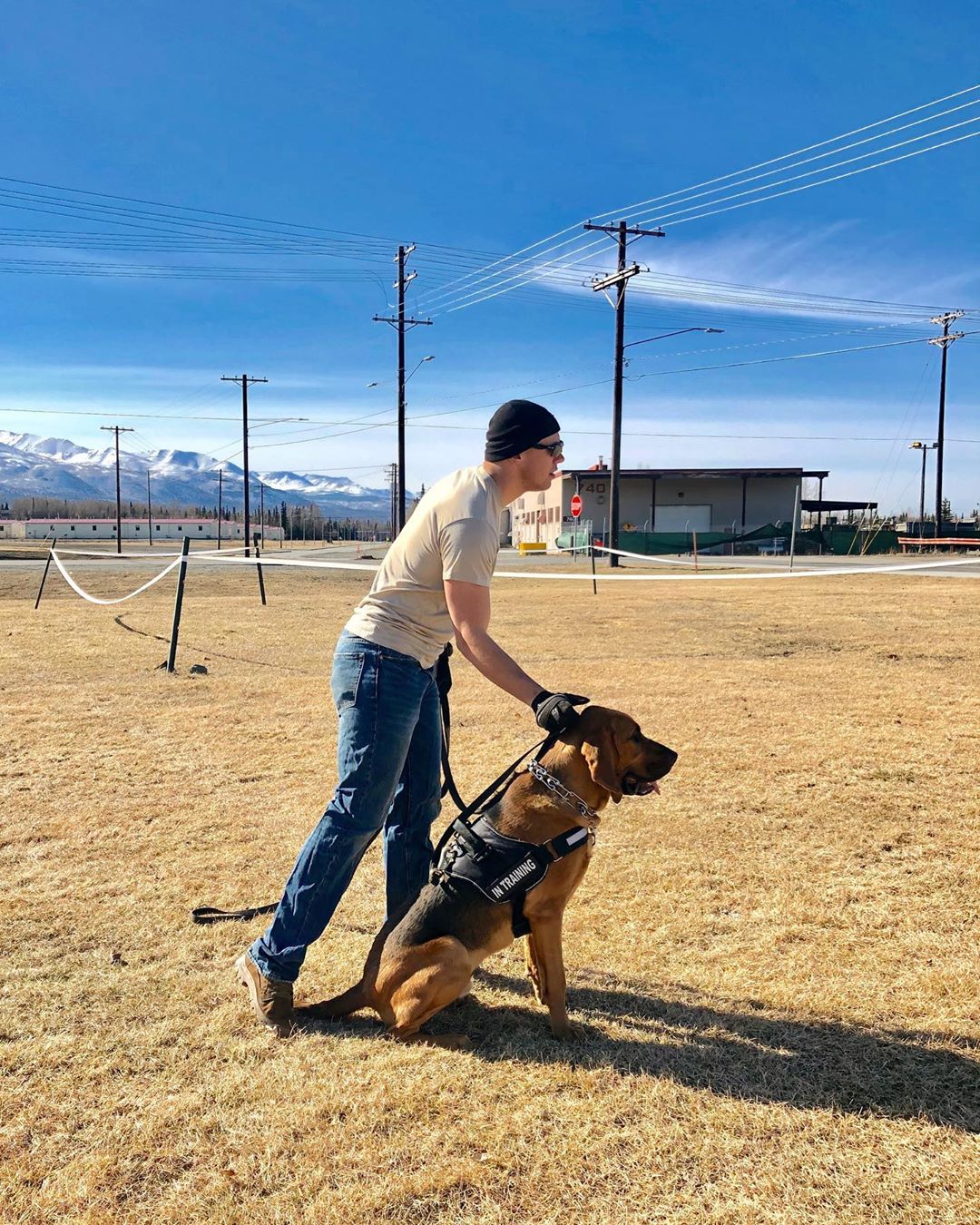
Bloodhounds are dogs that think a lot and are slow in everything related to study. In addition, unquestioning obedience is not their strong point. And yet, the “Belgian” has the basic prerequisites for becoming a well-mannered, controlled friend, given that he is smart, quick-witted, and keeps new commands and skills in his memory for a long time.
The main problems facing the trainer of the breed are the natural stubbornness of its representatives and the lack of interest in classes. And if you have to fight the first with perseverance, then in the second case it is better to rely on delicacies. Bloodhounds work more actively and with more interest for a treat than just praise. Lessons are wiser not to delay. The maximum that the breed can withstand is 15-20 minutes, after which concentration is replaced by boredom, and attention is switched to other external stimuli. It interferes with the diligence of long-eared investigators and a phenomenal instinct: a bloodhound can distract any, even the most elusive smell, which he will follow like a lunatic.
Restrictive and prohibitive commands “Come to me!” Are the first to be introduced into the consciousness of a dog. and “No!”, which is due to the psychological characteristics of the breed. Not busy and bored bloodhounds are constantly drawn to harmful deeds and destruction, so as soon as the puppy is two months old, hurry to show the young minx that in this world he is not allowed to do everything. Gradually, you can expand the command vocabulary of the hound, explaining to her the meaning of such requirements as “Aport!” and others. As for standard training courses, then, working with an experienced owner or a professional dog handler, Bloodhounds can easily cope with UGS and OKD, provided that the trainer does not put pressure on the dog, but tries to convey to it the importance of specific commands and actions.
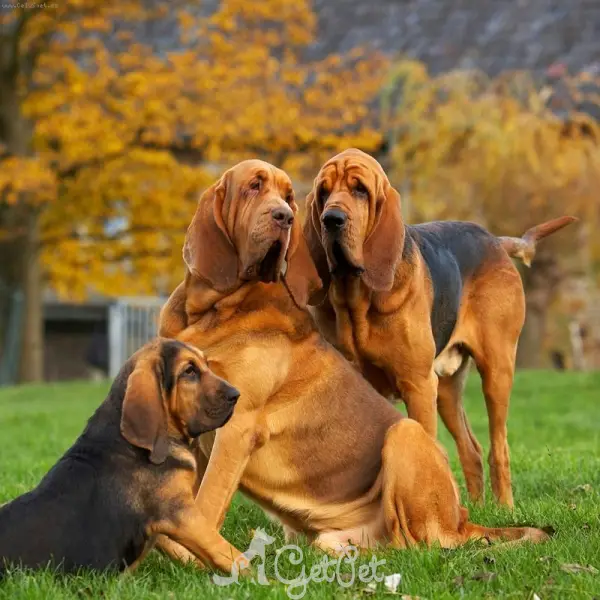
Bloodhound is a classic “sniffer” capable of highlighting the desired trail among thousands of other strong smells and not losing it for tens, or even hundreds of kilometers. In addition, he has practically no rivals in his search for the old trail: the most talented representatives of the breed successfully work with “odorous evidence” two weeks ago.
In the forest, the Bloodhound behaves professionally and persistently, not deviating from a self-constructed route until the prey is found. Only in this case, the dog will give its deaf, lion-like formidable voice. Since the breed does not have a narrow specialization, Bloodhounds are equally successful in hunting large games like wild boars and elk, as well as various small games like badgers. Females remain the most prey in terms of trophies, although there are real nuggets among males.
Best of all, the breed is given hunting on the blood trail, therefore, tests in this discipline are often carried out among its representatives. It happens in the following way: a winding blood “path” is laid in the forest belt, at the end of which there is an impromptu prey – a wild boar skin smelling of blood. Individual competitors are put on a long leash and allowed to follow the trail. At the same time, an instructor follows the bloodhound with the owner, noting the working qualities of the four-legged contestant: his interest in work, cornering, attitude to the shot and the prey found.
Mostly the USA prefers using bloodhounds as bloodhounds. Usually, dogs are looking for missing people, and also help to find victims of natural and man-made disasters. Anatomical features help the hounds in this. For example, a dog’s long, drooping ears work like an impromptu fan, capturing the desired smell and bringing it to the nose, but at the same time blocking and cutting off distracting “aromas” from the outside. The folds on the bloodhound’s forehead form a small hood, narrowing the field of view during the search. This helps the hound to concentrate on work and not be distracted by what is happening around.
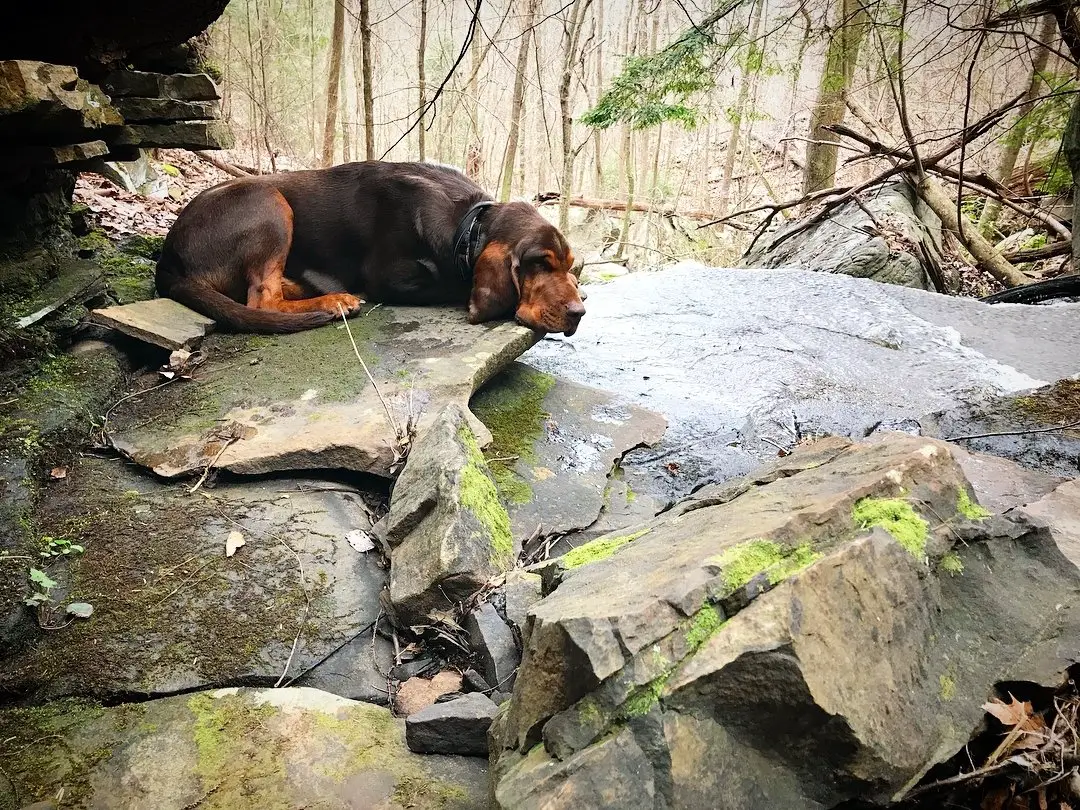
The Bloodhound is a breed that is poorly adapted to apartment living, although among breeders it is customary to assert the opposite. Representatives of this family are large-sized creatures that do not possess outstanding grace, so even in the most spacious apartment, they will be cramped. Do not discount the long strong tail of the dog, with which it will touch the furniture, and at the same time sweep small objects from horizontal surfaces. In addition, it is worth saving the nerves of the neighbors in the house, who are unlikely to appreciate the rare, but such “inspiring” barking of your ward.
Hounds dogs, forced to while away the days in the apartment, sin with destructive behavior and often make adjustments to the interior of the house. They are also partial to floor coverings and willingly chew on linoleum and laminate. Accordingly, starting a bloodhound without having a private house with at least a small courtyard is a quest for especially stubborn and imperturbable owners. Moreover, the breed does not require a luxurious country mansion with a fenced hectare of land. A small house in the countryside or the suburbs is enough, given that the Bloodhound easily gets used to the bustling city rhythm if they walk a lot with it, and in the season they take it out to work in the forest.
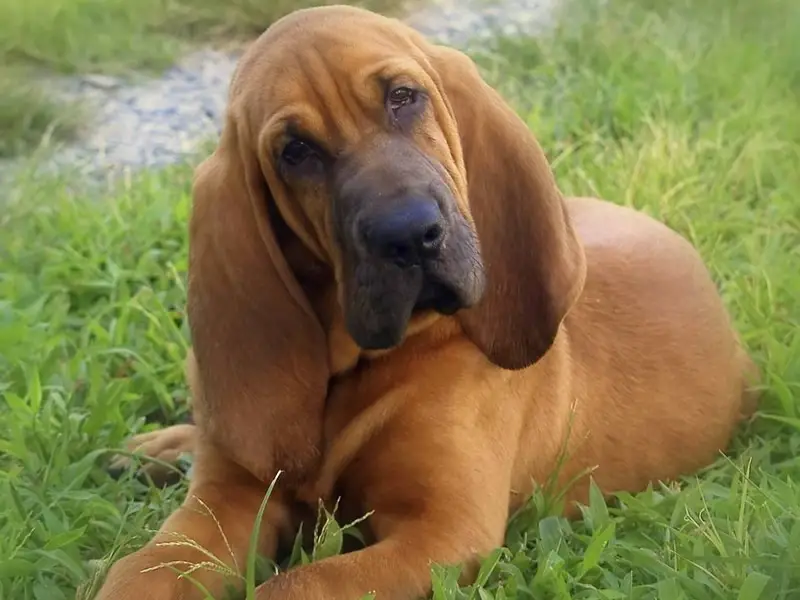
The Bloodhound is a dog with a short, seasonally shedding coat that requires minimal grooming. Usually “Belgians” are not combed, but once a week they are passed over their bodies with a rubber mitten, collecting dead hairs and massaging the skin. It is better to wash the Bloodhound, if it is not a show animal, as it gets dirty, with a shampoo for short-haired breeds.
The most problematic parts of the body in terms of grooming are the head and ears of the dog. In particular, to keep the hound looking neat, it will have to regularly wipe its face throughout the day. Bloodhounds are very slobbering, and if you don’t watch their mouths, the furniture in the house will be hung with slippery “fringes”, and puddles will grow on the floor, on which the master’s slippers glide so “cheerfully”. Folds and wrinkles on the head of an animal are not only part of the breed’s image, but also a serious problem, as the skin in them often melts, which leads to pyoderma (dermatitis). So periodically wrinkles on the face should be wiped with drying lotions based on chlorhexidine.
Bloodhound ears also need care. Not only do they catch a lot of dirt and dust after each walk and require thorough washing, but they also need ventilation. To do this, you need to lift the ear sheet and shake it vigorously to ensure air circulation in the ear canal. You cannot neglect the daily inspection of the ear funnel to promptly remove the secretion and dirt accumulated in it.
The hygiene of the bloodhound’s eyes is to prevent their souring, so wipe them with a strong tea infusion every 7 days. The teeth can be brushed once a week, but the dog’s mouth should be checked daily. After walks, bloodhounds often bring bones and carrion into the house, however, because of the massive wings, it is not always possible to see the “prey” in the pet’s mouth. After the walk, arrange for the hound to inspect the oral cavity for any foreign “artifacts” in it.
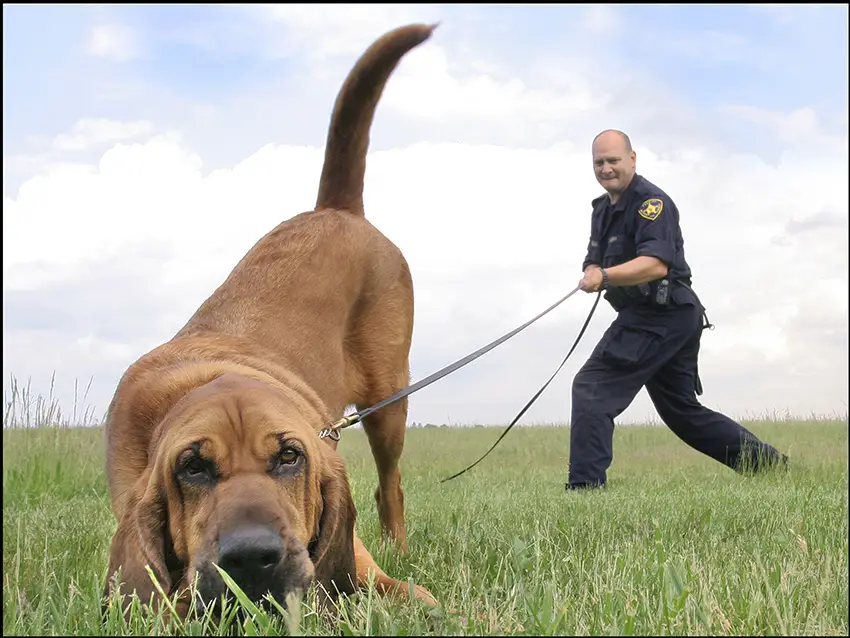
Walking with a bloodhound is both fitness and training of the owner’s attention at the same time. Half-hour trips to the store and back are not an option in a particular case. For a dog to spend at least 70% of its internal battery charge, you need one and a half, or preferably two hours of jogging, active games, and training, and there should be at least two such classes per day. Up to 8 months, puppies are not loaded with excessive physical activity, they are not allowed to go down and upstairs, so as not to deform their legs.
It is necessary to take the Bloodhound out into the street in the conditions of any settlement strictly on a leash. If the animal attacks an interesting trail, you will have to catch up with it long and hard. In addition, due to the peculiarities of the anatomy and genetic predisposition to diseases of the digestive system, bloodhounds are not walked immediately after or before meals. At least 1.5-2 hours should pass between eating and going out.
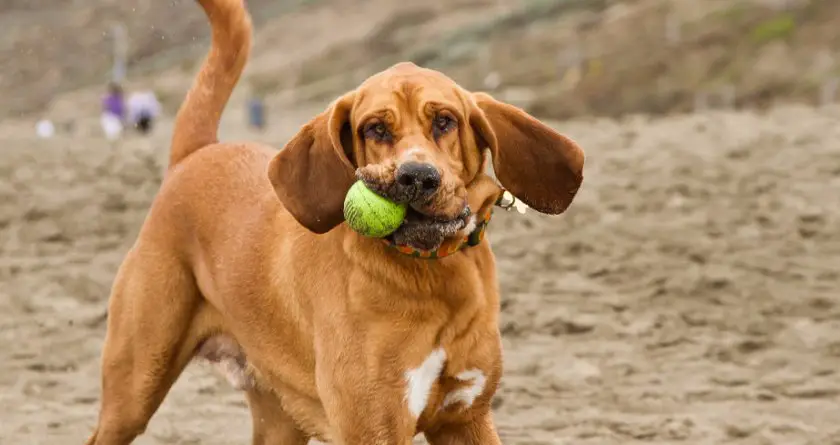
Bloodhounds do not need a specific diet and are content with the classic dog menu, consisting of lean meat, offal, fish fillets, dairy products, cereals (no more than 20% of the total diet), and vegetables. Rejection of natural nutrition in favor of high-quality “drying” is also possible. The only thing is that you will have to take into account the breed’s tendency to bloating and give the pet food in small portions. For example, a morning or evening meal can be halved and fed to the Bloodhound in two portions.
Good prevention of intestinal volvulus that hounds are prone to be a food bowl set at an angle and fixed in this position. In addition, it is important to calculate the calorie content of the diet, tracking its balance – the information is well-known, which managed to get bored, but does not lose its relevance for both pets and show individuals. Do not forget that the championship at the show does not shine for overly well-fed, as well as too lean bloodhounds, therefore, you can only feed the dog intensively at puppyhood. Although here it is better not to overdo it, so as not to load the baby’s fragile joints.
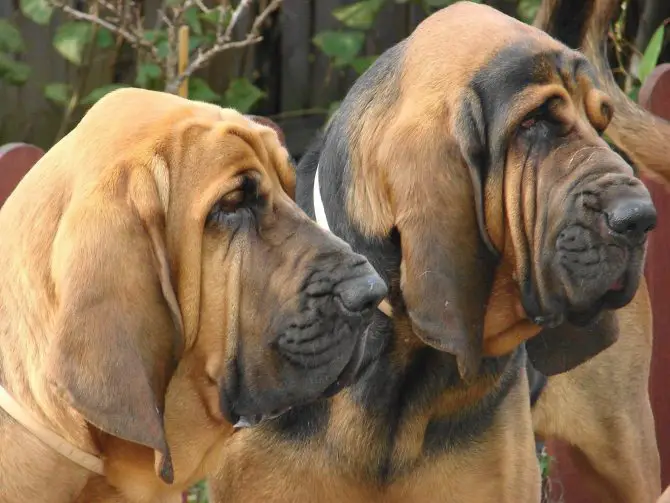
The most common disease among bloodhounds is dysplasia of the hip (more common) and elbow joints. The deep chest, typical of all members of the breed, can cause unpleasant symptoms such as bloating and volvulus, which are often fatal. Particularly susceptible to ailment are individuals who absorb food in large portions and walk immediately after eating. Among other things, bloodhounds have a predisposition to dermatitis, epilepsy, as well as anomalies in the development of the eyelid (eversion/volvulus).
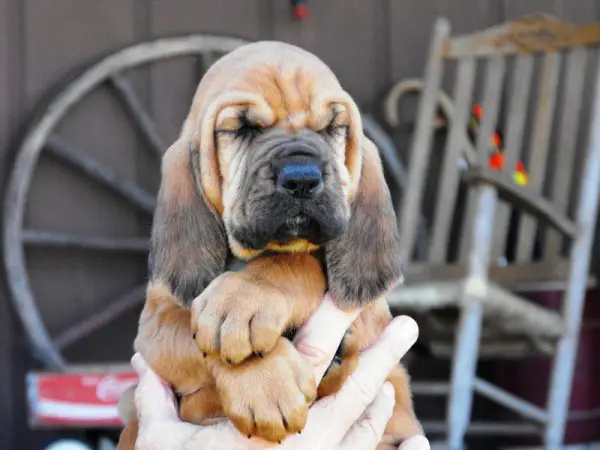
How to choose a puppy?
There can be from 7 to 10 puppies in litters, although cases when more or fewer babies are born, are also not uncommon.
The best age to buy a Bloodhound puppy is 2-3 months. It is also possible to take older individuals, but it will be more difficult to educate and train them.
Bloodhound babies need a lot of free space for normal development, so choose breeders who prefer country cultivation. Keeping an adult female and her restless cubs in an apartment is a sheer mockery of the breed.
It is normal for a Bloodhound puppy to be overweight in the first months of life. The main thing is that it does not survive until 8 months of age: the breed is prone to obesity, which entails several ailments no less dangerous to health.
Check with your dealer if bloodhound breeders have been tested for hereditary dysplasia. Breeders who have nothing to hide are willing to share X-rays and test results with customers.
Check what kind of litter this female has. It is worth finding out not only the total number of births but also to find out at what intervals the litters were born. If less than a year has passed between the last two matings, it is logical to assume that the breeder is simply making money off the animals, disregarding their health.
When choosing a future hunter, find out if his closest ancestors have working diplomas. A Bloodhound puppy usually inherits parental talents from first-class trackers.
Bloodhounds are often purchased without any clear understanding of what goes into owning one. There are many Bloodhounds in need of adoption and or fostering. There are some rescues that we have not listed. If you don’t see a rescue listed for your area, contact the national breed club or a local breed club and they can point you toward a Bloodhound rescue.
Raising a bloodhound is not an easy process. They sincerely love the owner and are smart, but at the same time stubborn and independent.
